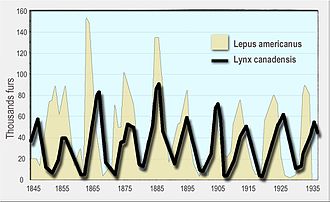Snowshoe hare






Snowshoe hare (Lepus americanus), also known as the varying hare, is a species of hare native to North America. It is well adapted to the cold environments found in its range, which includes forests and mountainous regions across Canada, Alaska, and northern parts of the United States. The snowshoe hare is named for its large hind feet, which are covered with dense fur and have a shape reminiscent of snowshoes, helping it to move effectively in deep snow.
Description[edit]
The snowshoe hare is characterized by its large back feet and the seasonal variation in its fur color, changing from brown or gray in the summer to white in the winter. This color change provides camouflage against predators in the varying landscapes. Adult snowshoe hares have a body length of approximately 36 to 52 cm (14 to 20 inches) and can weigh between 1.3 to 1.7 kg (2.9 to 3.7 pounds).
Habitat[edit]
Snowshoe hares are found in boreal forests and upper montane forests. They prefer dense cover provided by thickets and coniferous forests, which offer protection from predators. The hare's habitat is also characterized by the presence of shrubs and small trees, which provide food, especially in winter.
Behavior[edit]
Snowshoe hares are primarily nocturnal and are most active during twilight hours. They are solitary animals but may be seen in feeding areas in groups. Their diet consists mainly of grasses, ferns, and leaves in summer, and twigs, bark, and buds of woody plants in winter. Snowshoe hares are known for their ability to make large leaps and can reach speeds of up to 27 mph (43 km/h) when evading predators.
Reproduction[edit]
The breeding season for snowshoe hares begins in late March and can last until August. Females can have two to three litters per year, with each litter consisting of one to eight young, known as leverets. The leverets are born fully furred and with their eyes open, allowing them to be somewhat independent shortly after birth.
Predation and Survival[edit]
Predators of the snowshoe hare include the lynx, coyote, and great horned owl, among others. The hare's population cycles in a roughly ten-year pattern of boom and bust, which is closely linked to the population of its primary predator, the lynx. These cycles have significant impacts on the broader ecosystem, affecting the populations of other species within their habitat.
Conservation Status[edit]
The snowshoe hare is currently listed as Least Concern by the IUCN Red List, indicating it is not at immediate risk of widespread decline. However, habitat destruction and climate change pose potential threats to its populations, particularly affecting the hare's camouflage and exposing it to predators.
Cultural Significance[edit]
The snowshoe hare has played a role in the folklore and traditions of indigenous peoples in North America. It is also a popular animal in recreational hunting and is pursued for its fur and meat.
Ad. Transform your life with W8MD's Budget GLP-1 injections from $75


W8MD offers a medical weight loss program to lose weight in Philadelphia. Our physician-supervised medical weight loss provides:
- Weight loss injections in NYC (generic and brand names):
- Zepbound / Mounjaro, Wegovy / Ozempic, Saxenda
- Most insurances accepted or discounted self-pay rates. We will obtain insurance prior authorizations if needed.
- Generic GLP1 weight loss injections from $75 for the starting dose.
- Also offer prescription weight loss medications including Phentermine, Qsymia, Diethylpropion, Contrave etc.
NYC weight loss doctor appointmentsNYC weight loss doctor appointments
Start your NYC weight loss journey today at our NYC medical weight loss and Philadelphia medical weight loss clinics.
- Call 718-946-5500 to lose weight in NYC or for medical weight loss in Philadelphia 215-676-2334.
- Tags:NYC medical weight loss, Philadelphia lose weight Zepbound NYC, Budget GLP1 weight loss injections, Wegovy Philadelphia, Wegovy NYC, Philadelphia medical weight loss, Brookly weight loss and Wegovy NYC
|
WikiMD's Wellness Encyclopedia |
| Let Food Be Thy Medicine Medicine Thy Food - Hippocrates |
Medical Disclaimer: WikiMD is not a substitute for professional medical advice. The information on WikiMD is provided as an information resource only, may be incorrect, outdated or misleading, and is not to be used or relied on for any diagnostic or treatment purposes. Please consult your health care provider before making any healthcare decisions or for guidance about a specific medical condition. WikiMD expressly disclaims responsibility, and shall have no liability, for any damages, loss, injury, or liability whatsoever suffered as a result of your reliance on the information contained in this site. By visiting this site you agree to the foregoing terms and conditions, which may from time to time be changed or supplemented by WikiMD. If you do not agree to the foregoing terms and conditions, you should not enter or use this site. See full disclaimer.
Credits:Most images are courtesy of Wikimedia commons, and templates, categories Wikipedia, licensed under CC BY SA or similar.
Translate this page: - East Asian
中文,
日本,
한국어,
South Asian
हिन्दी,
தமிழ்,
తెలుగు,
Urdu,
ಕನ್ನಡ,
Southeast Asian
Indonesian,
Vietnamese,
Thai,
မြန်မာဘာသာ,
বাংলা
European
español,
Deutsch,
français,
Greek,
português do Brasil,
polski,
română,
русский,
Nederlands,
norsk,
svenska,
suomi,
Italian
Middle Eastern & African
عربى,
Turkish,
Persian,
Hebrew,
Afrikaans,
isiZulu,
Kiswahili,
Other
Bulgarian,
Hungarian,
Czech,
Swedish,
മലയാളം,
मराठी,
ਪੰਜਾਬੀ,
ગુજરાતી,
Portuguese,
Ukrainian
